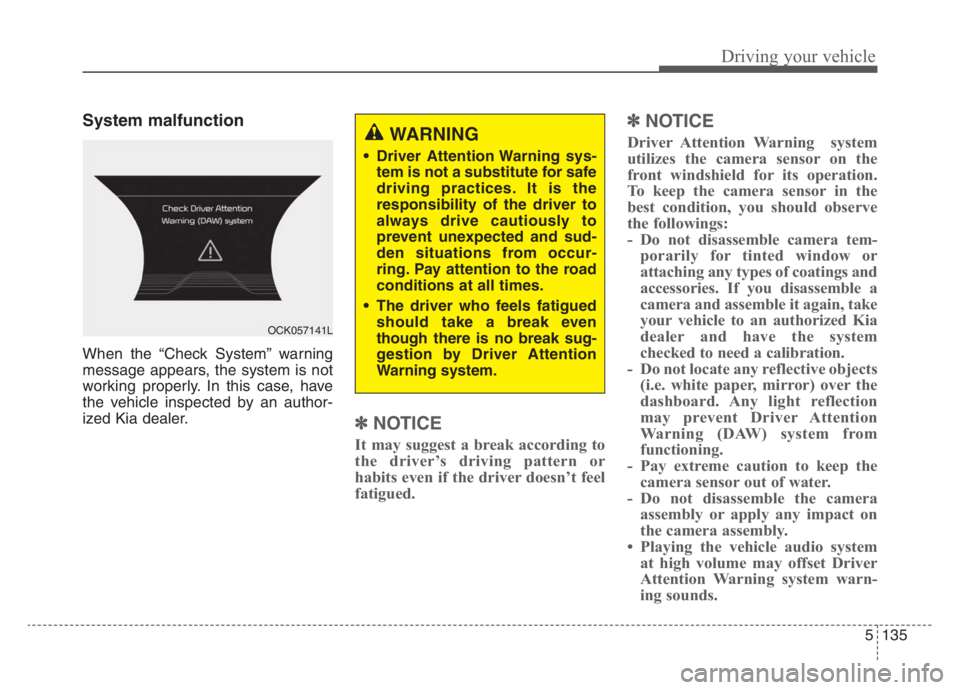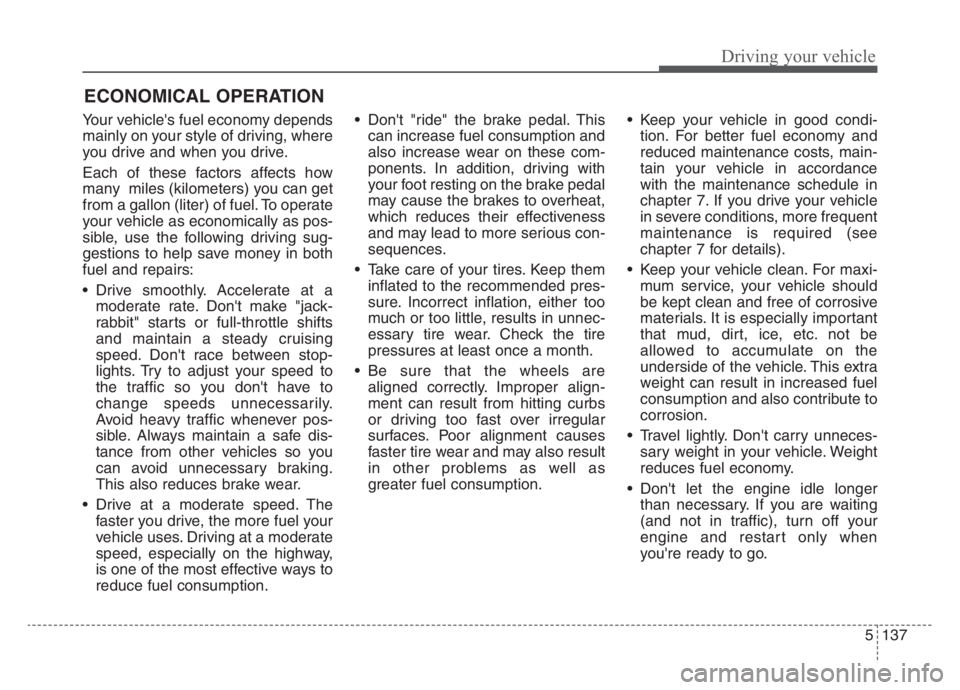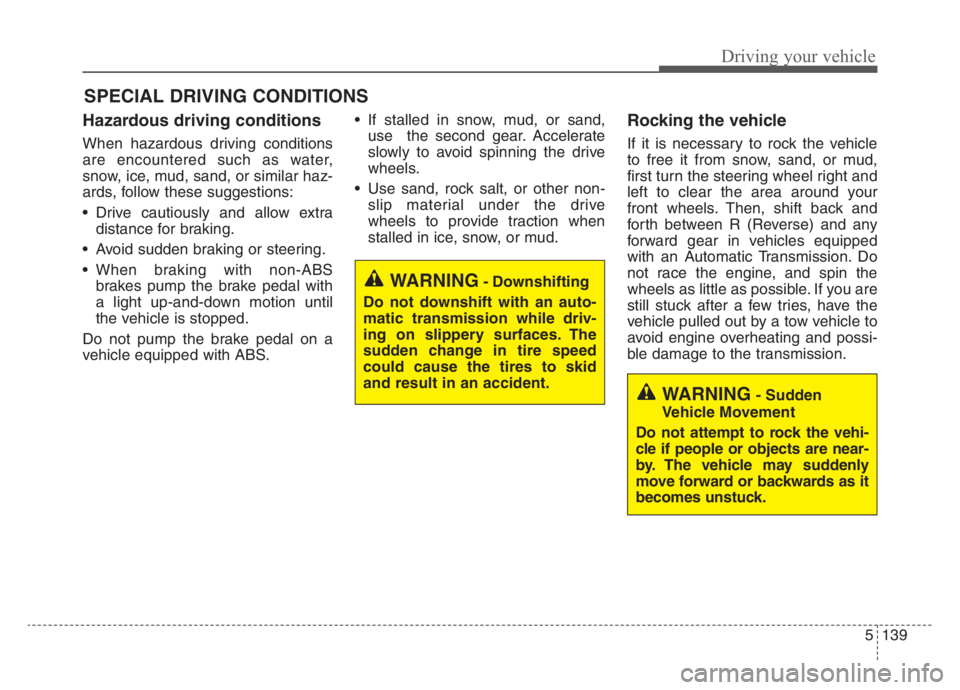KIA STINGER 2021 Owners Manual
Manufacturer: KIA, Model Year: 2021, Model line: STINGER, Model: KIA STINGER 2021Pages: 585, PDF Size: 10.87 MB
Page 391 of 585

Driving your vehicle
130 5
If the system does not work properly,
a warning message will appear and
the light on the switch will turn off. The
system will turn off automatically.
We recommend that the system be
checked by an authorized Kia dealer.
Non-operating condition
Outside rearview mirror may not
alert the driver when:
- The outside rearview mirror housing
is damaged or covered with debris.
- The window is covered with debris.
- The windows are severely tinted.
Driver's attention
The driver must be cautious in the
below situations, because the system
may not detect other vehicles or
objects in certain circumstances.
- The vehicle drives on a curved
road or through a tollgate.
- The sensor is covered with rain,
snow, mud, etc.
- The rear bumper, in which the sen-
sor is located, is covered or
blocked with a foreign matter such
as a sticker, a bumper guard, a
bicycle stand, etc.
- The rear bumper is damaged, or
the sensor is out of the original
default position.
- The vehicle height gets lower or
higher due to heavy loading in a lift-
gate, abnormal tire pressure, etc.
- The vehicle drives in a bad weath-
er such as heavy rain or snow.
- There is a fixed object near the
vehicle, such as a guardrail,
pedestrian, animal, tunnel, etc.
- A big vehicle is near such as a bus
or truck.
OCK057055L
Page 392 of 585

5131
Driving your vehicle
- A motorcycle or bicycle is near.
- A flat trailer is near.
- If the vehicle has started at the
same time as the vehicle next to
you and has accelerated.
- When the other vehicle passes at a
very fast speed.
- While changing lanes.
- When going down or up a steep
road where the height of the lane is
different.
- When the other vehicle approach-
es very close.
- When a trailer or carrier is
installed.
- When the temperature of the rear
bumper is very high or low.
- When the sensors are blocked by
other vehicles, walls or parking-lot
pillars.
- When the detected vehicle also
moves back, as your vehicle drives
back.
- If there are small things like
Shopping cart, baby carriage and
pedestrians.- If there is low height vehicle like
sport vehicle.
- When other vehicles are close to
your vehicle.
- When the vehicle in the next lane
moves two lanes away from you
OR when the vehicle two lanes
away moves to the next lane from
you.
- When driving through a narrow
road with many plants.
- When driving on wet surface.
- The vehicle is driven near areas
containing metal substances such
as a construction zone, railroad,
etc.
- When the surrounding vehicle or
structure is driving in a wide area
(desert, field, suburb etc.)The Certification applies;
This device complies with Part 15
of the FCC rules.
Operation is subject to the following
two conditions:
1. This device may not cause harm-
ful interference, and
2. This device must accept any inter-
ference received, including inter-
ference that may cause undesired
operation.
OCK059209L
Page 393 of 585

Driving your vehicle
132 5
Driver Attention Warning (DAW) sys-
tem is designed to warn the driver of
potentially hazardous driving situa-
tions if it detects inattentive driving
practices.System setting and activation
System setting
Driver Attention Warning system is
set in the OFF position when your
vehicle is first delivered to you from
the factory.
To turn ON Driver Attention
Warning system, turn on the
engine, and then select 'User
Settings →Driver Assistance →
Driver Attention Warning →
Normal/Early' on the LCD display. The driver can select Driver
Attention Warning system mode.
- Off : Driver Attention Warning
system is deactivated.
- Normal : Driver Attention Warning
system alerts the driver of his/her
fatigue level or inattentive driving
practices.
- Early : Driver Attention Warning
system alerts the driver of his/her
fatigue level or inattentive driving
practices faster than Normal
mode.
The set-up of Driver Attention
Warning system will be maintained
when the engine is re-started.
DRIVER ATTENTION WARNING (DAW) SYSTEM (IF EQUIPPED)
Page 394 of 585

5133
Driving your vehicle
Display of the driver's attention
level
The driver can monitor their driving
conditions on the LCD display.- Select 'User Settings Mode' and
then 'Driver Assistance' on the
LCD display. (For more informa-
tion, refer to "LCD Display" in
chapter 4.)
The driver's attention level is dis-
played on the scale of 1 to 5. The
lower the number is, the more inat-
tentive the driver is.
The number decreases when the
driver does not take a break for a
certain period of time.
The number increases when the
driver attentively drives for a cer-
tain period of time.
When the driver turns on the sys-
tem while driving, it displays 'Last
Break time'.
Take a break
The "Consider taking a break"
message appears on the LCD dis-
play and a warning sounds to sug-
gest that the driver take a break
when the driver's attention level is
below 1.
Driver Attention Warning system
will not suggest a break when the
total driving time is shorter than 10
minutes.
OCK057137L
OCK057138L
OCK057139L
Page 395 of 585

Driving your vehicle
134 5
Resetting the system
The last break time is set to 00:00
and the driver's attention level is
set to 5 (very attentive) when the
driver resets Driver Attention
Warning system.
Driver Attention Warning system
resets in the following situations.- The engine is turned OFF.
- The driver unfastens the seat belt
and then opens the driver’s door.
- The driver takes a break from
driving that lasts more than 10
minutes.
The driver attention warning sys-
tem operates again, when the driv-
er restarts driving.
System disabled
Driver Attention Warning system
enters the ready status and displays
the 'Disabled' screen in the following
situations.
- The camera sensor is unable to
detect the lanes.
- Driving speed remains under 37
mph (60 km/h) or over 112 mph
(180 km/h).
OCK057140L
Page 396 of 585

5135
Driving your vehicle
System malfunction
When the “Check System” warning
message appears, the system is not
working properly. In this case, have
the vehicle inspected by an author-
ized Kia dealer.
✽ ✽
NOTICE
It may suggest a break according to
the driver’s driving pattern or
habits even if the driver doesn’t feel
fatigued.
✽ ✽
NOTICE
Driver Attention Warning system
utilizes the camera sensor on the
front windshield for its operation.
To keep the camera sensor in the
best condition, you should observe
the followings:
- Do not disassemble camera tem-
porarily for tinted window or
attaching any types of coatings and
accessories. If you disassemble a
camera and assemble it again, take
your vehicle to an authorized Kia
dealer and have the system
checked to need a calibration.
- Do not locate any reflective objects
(i.e. white paper, mirror) over the
dashboard. Any light reflection
may prevent Driver Attention
Warning (DAW) system from
functioning.
- Pay extreme caution to keep the
camera sensor out of water.
- Do not disassemble the camera
assembly or apply any impact on
the camera assembly.
• Playing the vehicle audio system
at high volume may offset Driver
Attention Warning system warn-
ing sounds.
OCK057141L
WARNING
Driver Attention Warning sys-
tem is not a substitute for safe
driving practices. It is the
responsibility of the driver to
always drive cautiously to
prevent unexpected and sud-
den situations from occur-
ring. Pay attention to the road
conditions at all times.
The driver who feels fatigued
should take a break even
though there is no break sug-
gestion by Driver Attention
Warning system.
Page 397 of 585

Driving your vehicle
136 5
✽
✽
NOTICE
Driver Attention Warning system
may not provide alerts in the follow-
ing situations:
• The lane detection performance is
limited. (For more information,
refer to “Lane Keeping Assist
(LKA) system” in this chapter.)
• The vehicle is driven erratically or
is abruptly turned for obstacle
avoidance (e.g. construction area,
other vehicles, fallen objects,
bumpy road).
• Forward drivability of the vehicle
is severely undermined (possibly
due to wide variation in tire pres-
sures, uneven tire wear-out, toe-
in/toe-out alignment).
• The vehicle drives on a curvy road.
• The vehicle drives on a bumpy
road.
• The vehicle drives through a
windy area.
(Continued)(Continued)
• The vehicle is controlled by the
following driving assist systems:
- Lane Keeping Assist (LKA) sys-
tem
- Forward Collision-Avoidance
Assist (FCA) System.
- Smart Cruise Control (SCC)
System
✽ ✽
NOTICE
Driver Attention Warning (DAW)
system does not detect actual driver
fatigue or drowsiness. The system
monitors driving and provides a
warning if it detects inattentive driv-
ing practices.
Page 398 of 585

5137
Driving your vehicle
Your vehicle's fuel economy depends
mainly on your style of driving, where
you drive and when you drive.
Each of these factors affects how
many miles (kilometers) you can get
from a gallon (liter) of fuel. To operate
your vehicle as economically as pos-
sible, use the following driving sug-
gestions to help save money in both
fuel and repairs:
Drive smoothly. Accelerate at a
moderate rate. Don't make "jack-
rabbit" starts or full-throttle shifts
and maintain a steady cruising
speed. Don't race between stop-
lights. Try to adjust your speed to
the traffic so you don't have to
change speeds unnecessarily.
Avoid heavy traffic whenever pos-
sible. Always maintain a safe dis-
tance from other vehicles so you
can avoid unnecessary braking.
This also reduces brake wear.
Drive at a moderate speed. The
faster you drive, the more fuel your
vehicle uses. Driving at a moderate
speed, especially on the highway,
is one of the most effective ways to
reduce fuel consumption. Don't "ride" the brake pedal. This
can increase fuel consumption and
also increase wear on these com-
ponents. In addition, driving with
your foot resting on the brake pedal
may cause the brakes to overheat,
which reduces their effectiveness
and may lead to more serious con-
sequences.
Take care of your tires. Keep them
inflated to the recommended pres-
sure. Incorrect inflation, either too
much or too little, results in unnec-
essary tire wear. Check the tire
pressures at least once a month.
Be sure that the wheels are
aligned correctly. Improper align-
ment can result from hitting curbs
or driving too fast over irregular
surfaces. Poor alignment causes
faster tire wear and may also result
in other problems as well as
greater fuel consumption. Keep your vehicle in good condi-
tion. For better fuel economy and
reduced maintenance costs, main-
tain your vehicle in accordance
with the maintenance schedule in
chapter 7. If you drive your vehicle
in severe conditions, more frequent
maintenance is required (see
chapter 7 for details).
Keep your vehicle clean. For maxi-
mum service, your vehicle should
be kept clean and free of corrosive
materials. It is especially important
that mud, dirt, ice, etc. not be
allowed to accumulate on the
underside of the vehicle. This extra
weight can result in increased fuel
consumption and also contribute to
corrosion.
Travel lightly. Don't carry unneces-
sary weight in your vehicle. Weight
reduces fuel economy.
Don't let the engine idle longer
than necessary. If you are waiting
(and not in traffic), turn off your
engine and restart only when
you're ready to go.
ECONOMICAL OPERATION
Page 399 of 585

Driving your vehicle
138 5
WARNING - Engine off
during motion
Never turn the engine off to
coast down hills or anytime the
vehicle is in motion. The power
steering and power brakes will
not function properly without the
engine running. In addition, turn-
ing off the ignition while driving
could lead to out of working
power driven steering wheel and
hard to control steering wheel.
Keep the engine on and down-
shift to an appropriate gear for
an engine braking effect.
Remember, your vehicle does not
require extended warm-up. After
the engine has started, allow the
engine to run for 10 to 20 seconds
prior to placing the vehicle in gear.
In very cold weather, however, give
your engine a slightly longer warm-
up period.
Don't "lug" or "over-rev" the engine.
Lugging is driving too slowly in a
very high gear resulting in engine
bucking. If this happens, shift to a
lower gear. Over-revving is racing
the engine beyond its safe limit.
This can be avoided by shifting at
the recommended speed. Use your air conditioning sparingly.
The air conditioning system is
operated by engine power so your
fuel economy is reduced when you
use it.
Open windows at high speeds can
reduce fuel economy.
Fuel economy is less in crosswinds
and headwinds. To help offset
some of this loss, slow down when
driving in these conditions.
Keeping a vehicle in good operating
condition is important both for econ-
omy and safety. Therefore, have an
authorized Kia dealer perform
scheduled inspections and mainte-
nance.
Page 400 of 585

5139
Driving your vehicle
Hazardous driving conditions
When hazardous driving conditions
are encountered such as water,
snow, ice, mud, sand, or similar haz-
ards, follow these suggestions:
Drive cautiously and allow extra
distance for braking.
Avoid sudden braking or steering.
When braking with non-ABS
brakes pump the brake pedal with
a light up-and-down motion until
the vehicle is stopped.
Do not pump the brake pedal on a
vehicle equipped with ABS. If stalled in snow, mud, or sand,
use the second gear. Accelerate
slowly to avoid spinning the drive
wheels.
Use sand, rock salt, or other non-
slip material under the drive
wheels to provide traction when
stalled in ice, snow, or mud.
Rocking the vehicle
If it is necessary to rock the vehicle
to free it from snow, sand, or mud,
first turn the steering wheel right and
left to clear the area around your
front wheels. Then, shift back and
forth between R (Reverse) and any
forward gear in vehicles equipped
with an Automatic Transmission. Do
not race the engine, and spin the
wheels as little as possible. If you are
still stuck after a few tries, have the
vehicle pulled out by a tow vehicle to
avoid engine overheating and possi-
ble damage to the transmission.
SPECIAL DRIVING CONDITIONS
WARNING- Downshifting
Do not downshift with an auto-
matic transmission while driv-
ing on slippery surfaces. The
sudden change in tire speed
could cause the tires to skid
and result in an accident.
WARNING- Sudden
Vehicle Movement
Do not attempt to rock the vehi-
cle if people or objects are near-
by. The vehicle may suddenly
move forward or backwards as it
becomes unstuck.